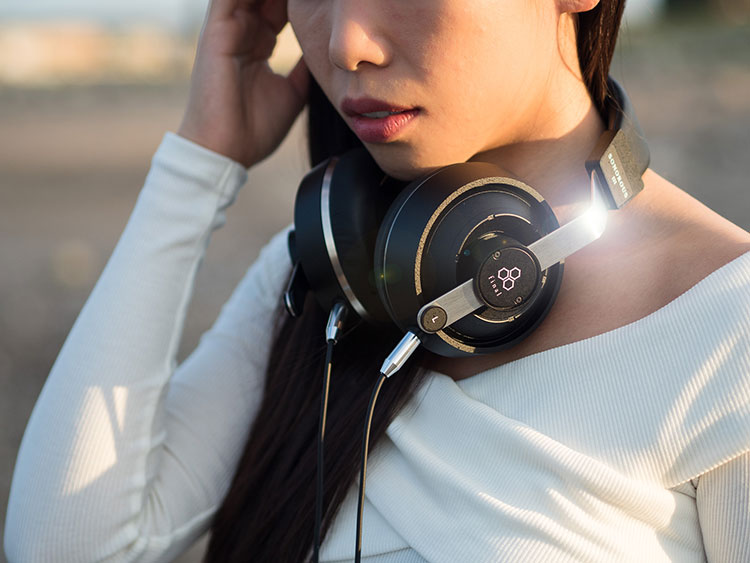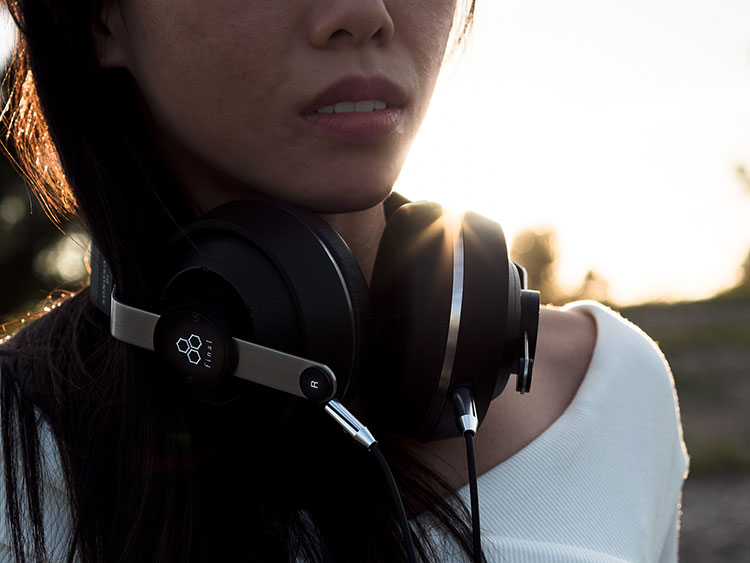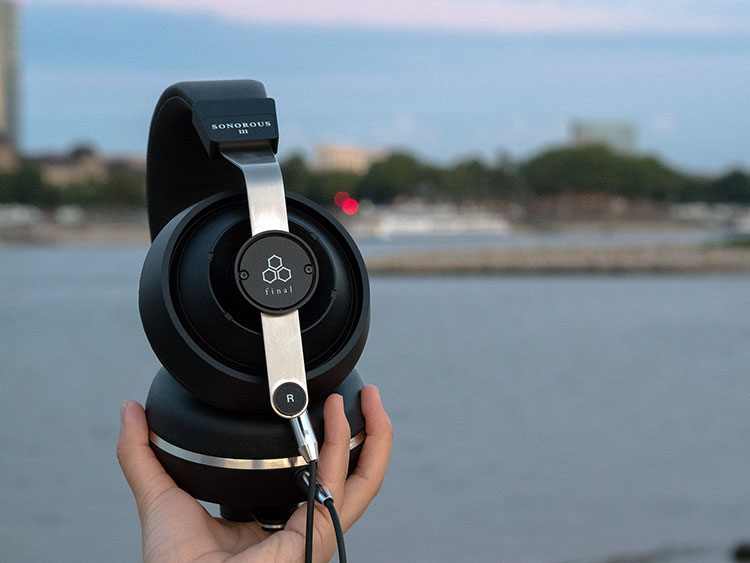Sound Quality
Tonality
The Sonorous III does not fall short of expectations. On the contrary, it is quite a pleasant surprise and performs better than the minimal design had me believe at first. The Final Sonorous III has a very smooth and accurate sound. An enjoyable hint of warmth is added for a relaxed presentation. The overall frequency range is very linear from the sub-bass all the way up to super-high frequencies, all while impressing with an expansive soundstage. I cannot really ascribe any flaws but I found a few points where there’s room for improvement.
Bass
Final does a good job with reproducing low frequencies but it somewhat leaves me wanting more. The full bass range is covered nicely all the way down to sub-bass and rumble. Don’t get me wrong, the bass is not pronounced, it is just right! I don’t notice any bass hump or upper bass boost nor any lack of sub-bass. The texture is quite detailed and sounds phenomenal with strings (bass, cello, harp) as well as low-tuned bass guitars.
But I also miss some punch and impact. The bass is quite relaxed, unobtrusive and pleases the attentive listener. It is a matter of preference really, but I don’t mind a bit more of an impact occasionally. Some jazz albums won’t get my toes moving unless I’ve listened to one or two tracks and adjusted fully. It is usually the mids that catch my attention first. I also found that on quicker bass tracks some other headphones would perform more accurately with a faster decay. The Sonorous III isn’t slow on the bass but they are not quite reference material either.
Mids
Midrange reproduction is great. Not just voices but any instrument that performs in the mid-range sound pretty good. I have to admit, I wasn’t fully convinced at first. The music sounded distant to me and I was missing the intimacy and overall plasticity. But this is just a matter of how the soundstage on these headphones actually works.
The more I was searching for the suspected flaw, I noticed how accurate mid frequencies actually are. Male voices, female voices, woodwinds, brass, pianos, and strings all sound very pleasing and accurate. However, there is a hint of a veil that results in a very laid back presentation.
High mids are quite soft. It takes a bit away from what otherwise would have been an incredible timbre and gives a very slight hollow or fizzy feel that fades away quickly once the music plays and you sit comfortably in a chair.
Treble
The highs continue to impress with linearity. Actually, this is where the Sonorous III stands out the most, in my opinion. Cymbals are crisp and violins detailed. Furthermore, these have an abundance of air; I rarely enjoyed top-end frequencies in a closed set of headphones this much.
Soundstage
The Sonorous III might as well challenge open headphones. The company implemented a feature they call BAM – balancing air movement. I am not sure what this does exactly and if this is the cause of what I am hearing, but the Sonorous III sounds spacious and open. I stand impressed by the big soundstage that slightly resembles the effect of Ultrasone’s S-Logic Plus but features better positioning of instruments.
Where the soundstage does fall short is with intimacy. Voices and instruments are quite distant based on my perception. Even – or especially – with fast-forward aggressive tracks I never sense any “in your face” feeling. Since I sense the music is being played with a gap around me, I do perceive instruments as a bit flat and not fully-fledged out three-dimensionally. The soundstage is broader than deep. It’s a subjective preference and every user has to decide for himself which he prefers.
Resolution
The resolution is quite high but details are buried in the texture. I do think the bass could be a little bit quicker too. For my taste, the presentation is not snappy enough and I wish cymbals would splash more while kick bass would actually move some air. It would make it easier to get lost in the music.
Reflections
The Sonorous III keeps reminding me of Hifiman’s RE-400, the small in-ear monitor that often had a paper-like character ascribed to it. The sound on these full-sized cans is not quite that light and if they were packaged as IEMs I would throw in a good portion of InEar StageDiver 2 as well. Yes, exactly, that is not bad at all!
As for full-sized cans, Sennheiser’s all-time favorite HD600 comes to mind with a big difference: the HD600’s soundstage is very close to your head and voices are very intimate; some would complain that they’re in your head even.
Final’s take is quite the opposite and throws you all the way back into the fifth or sixth row of a concert. I can’t really think of closed headphones that share the same characteristics, but I could imagine that proper use of S-Logic Plus could create a similar open feel in a closed body. As for linearity and timbre, the Final Sonorous III easily beat any similarly priced Ultrasone.
Select Comparisons
Oppo PM-3
This is difficult for me as the Oppos have grown to be a personal favorite. The PM-3 gets so many things so right. I love their design and comfort is simply top-notch. If I have both pairs laying on the table I’d grab the PM-3 nine out of ten times because of comfort alone. However, the large and bulky design of the S3 makes the PM-3 feel fragile. If the Sonorous only were more convenient to take along.
Going into detailed A/B comparison the first thing I noticed is that the PM-3 just nail the pace, rhythm, and timing. Bass is tight and punchy. Final has a hard time keeping up with the speed which might take away some of the experience for EDM or Rock music. While moving forward to vocal tracks I give this point to Final. Where the Sonorous is a bit too relaxed the PM-3 is too forward. If you like to daydream to Gregory Porter or Diana Krall, I prefer to grab the Final instead. It’s so easy to enjoy vocals for hours over hours.
While mids were a close call in favor of the Sonorous III, the highs are where Final is close to domination. Linearity, timbre, and especially air are just incredible! No splashy cymbals here and thus also less energy, but such openness does bring some joy. The soundstage on the Oppo is very intimate but it has great layering. Final’s take is a lot more ‘out of your head’ but the layers do not show quite as much depth.
As an all-rounder, I will not dethrone the Oppo PM-3. However, if it’s a closed headphone with open characteristics that you are searching for use at home, the Final Sonorous III might very well be to your preference. Especially if you mostly listen to Jazz and Classical.
Matchability
Efficiency
These headphones are very easy to drive. An iPhone will easily suffice to achieve high volumes and the sonic match isn’t poor either. I will recommend the use of an external DAC like the Cozoy Aegis for example. While the Aegis sometimes sounds too analytical and direct for my taste, I found it performed superbly with the Sonorous III. Control over bass and layering of instruments improved noticeably while not changing the headphones’ characteristics.
Tonal Pairing
I would have expected Chord’s Hugo to do its usual magic but this time, I was left rather unimpressed. The analog feel of the DAC doesn’t have much impact on the already analog feel of the headphones. Also, the great implementation of crossfeed went mostly unnoticed this time around.
The Hugo is pushing the headphones’ strengths instead of boosting the weaknesses and thus the overall impact is relatively small compared to cheaper offerings like the Aegis. If you have a Hugo laying around anyway, it won’t hurt to use it. But don’t go out spending that much money for use with the Sonorous III alone.
Taking the headphones over to the head out of my Onkyo vintage stereo system, I noticed the higher output impedance added warmth and weight to the sound signature. While it doesn’t sound bad at all, I do feel like this is not what Final was aiming for. The bass was moved forward and trying to steal attention. The focus should remain on mids and highs with a light and smooth signature. Personally, I conclude that a source with low output impedance is preferred.
Power
The Sonorous don’t need much power, a small O2 might possibly get most out of it already and paired with the details of an ODAC you have a great and affordable combo for semi-portable and home use.
Our Verdict
Though previously not too familiar with the brand, I have developed a strong sympathy for Final over the past days. Headphones don’t have to be portable and if you need a closed pair that reminds you of a speaker setup, the Sonorous III might be right up your alley.
I find them to be competitively priced just below the 400 $/€ price tag. Build quality and choice of materials is great, even though I strongly suggest to invest a few bucks into other ear pads. (I hear Shure SRH1540’s pads are compatible.)
I strongly recommend to put them on your watchlist if you mostly listen to Classical music or simply don’t want headphones to place you into the first row all the time.
Sonorous III Technical Specifications
- Signal to Noise Ratio SNR: 105 dB
- Sound Mode: Stereo
- Features: Detachable Cable, Flexible
- Connectivity Technology: Wired
- Impedance: 16 Ohm
- Cable Length: 1.50 m





